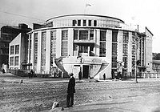
Konstantin Melnikov
Encyclopedia
Konstantin Stepanovich Melnikov (Russian: Константин Степанович Мельников; , Moscow
- November 28, 1974, id.) was a Russian architect
and painter
. His architectural work, compressed into a single decade (1923–1933), placed Melnikov on the front end of 1920s avant-garde
architecture. Although associated with the Constructivists
, Melnikov was an independent artist, not bound by the rules of a particular style or artistic group. In 1930s, Melnikov refused to conform with the rising stalinist architecture
, withdrew from practice and worked as a portrait painter and teacher until the end of his life.
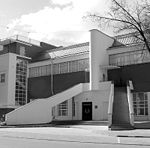 Konstantin Melnikov was born a fourth child in a family and was a vegetarian. His father, Stepan Illarionovich Melnikov, originally from Nizhny Novgorod
Konstantin Melnikov was born a fourth child in a family and was a vegetarian. His father, Stepan Illarionovich Melnikov, originally from Nizhny Novgorod
region, was a road maintenance foreman, employed by the Moscow Agricultural Academy. Mother, Yelena Grigorievna (née Repkina), came from the peasants of Zvenigorod
district. The whole family occupied a single room of a state-managed working class barrack in Hay Lodge (Соломенная Сторожка), then a quiet northern suburb of Moscow. Melnikovs tried hard to rise above bitter poverty, to return to farming and eventually relocated to their own small house and set their own dairy farm. Konstantin Melnikov later praised his father, who noticed little boy's addiction to drawing and regularly brought him scrap paper for drawing from the Academy. However, all the education they could afford was a two-year parish school (completed in 1903).
in 1904. One year later, he passed the admissions that selected a class of 11 out of 270 applicants. Melnikov studied at the School for 12 years, first completing General Education (1910), then graduating in Arts (1914) and Architecture (1917). Despite Chaplin's calls to concentrate on architecture, Melnikov leaned to painting; by the time he joined the Architecture classes, he already was a well-recognized portrait painter. Later, he recalled Konstantin Korovin
, Sergey Malyutin
and Abram Arkhipov
as his mentors in art; as for architecture, he gave his regards only to Ivan Zholtovsky, his professor in 1917-1918.
Melnikov married Anna Yablokova in 1912; they had two children, born in 1913 and 1915.
and the first years after Russian Revolution of 1917
, Melnikov worked within the Neoclassical tradition. Before the Revolution, he was involved in AMO Truck Plant
project. In 1918-1920, he was employed by the New Moscow planning workshop headed by Zholtovsky and Alexey Shchusev
, designing Khodynka
and Butyrsky District
sectors of the city.
Meanwhile, the Russian educational system collapsed; the new art college, VKhUTEMAS
, was formed in 1920. Its architectural faculty was split between three factions: An Academic Workshop (Ivan Zholtovsky), left-wing United Workshops (Nikolai Ladovsky
), and a joint workshop of Melnikov and Ilya Golosov, known as New Academy and Workshop No.2. Melnikov and Golosov resisted both the academic and left-wing camps; in 1924, when the management merged New Academy with Academic Workshop, Melnikov quit VKhUTEMAS. In 1923-1924, Melnikov temporarily associated himself with the ASNOVA
and LEF
artistic groups, however, he was not involved in public disputes and made no public statements. In particular, he clearly distanced himself from the Constructivist
group, led by Moisei Ginzburg
and Alexander Vesnin
.
His first success in architecture was a 1922 entry to a workers' housing contest. Codenamed Atom, Melnikov's design employed the sawtooth arrangement of units that became his trademark in later works. Unlike other, "revolutionary" projects, Atom was based on traditional single-family townhouse
and apartment units.
Melnikov's first materialized works were short-lived, temporary buildings. The first, a 1923 pavilion for the All-Russian Agriculture and Handicraft Exhibition, featured more Melnikov trademarks:
The latter feature is shared with the Constructivists; single-sloped, angled roof was against the constructivist canon but a good match to existing technologies: Soviet industry of 1920s did not have the technology for reliable flat roofing.
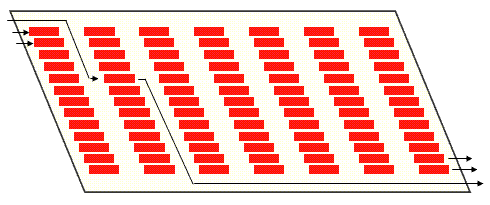 In 1925 Melnikov designed and built the Soviet pavilion at the Paris Exposition Internationale des Arts Décoratifs et Industriels Modernes
In 1925 Melnikov designed and built the Soviet pavilion at the Paris Exposition Internationale des Arts Décoratifs et Industriels Modernes
. The wooden pavilion, employing a combination of single-sloped roofs of different sizes, was regarded as being one of the most progressive buildings at the fair. Unlike other Paris pavilions, it was completed in less than a month, employing not more than 10 workers.
Still in Paris, Melnikov designed two privately-commissioned version of a ramped garage that never got past the conceptual drawing stage. The second version of this project, according to Andrés Jaque
's studies, has been strongly influential in contemporary architectects like Rem Koolhaas
, especially in his proposal for the National Library of France or Foreign Office's Yokohama Terminal. However, Melnikov found a useful pattern of placing cars in a garage (again, a sawtooth pattern) where cars could park and leave without using reverse gear. The second In Moscow, Melnikov saw a new fleet of Leyland buses hoarded in a yard in Zamoskvorechye
, and immediately proposed his concept to the city. The result, Bakhmetevsky Bus Garage
, housed 104 buses on 8500 square meters of an unconventional, parallelogram
-shaped floorplan with Vladimir Shukhov
's roof system.
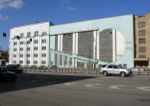 Melnikov later called this project "the start of my Golden Season". Bakhmetevsky Garage, sometimes incorrectly called a constructivist landmark, was very modestly styled in an indefinite "industrial" red brick. Melnikov's later garage buildings, on the contrary, possessed a clear avant-garde external styling (which has become badly damaged over time):
Melnikov later called this project "the start of my Golden Season". Bakhmetevsky Garage, sometimes incorrectly called a constructivist landmark, was very modestly styled in an indefinite "industrial" red brick. Melnikov's later garage buildings, on the contrary, possessed a clear avant-garde external styling (which has become badly damaged over time):
 The "golden season" of 1927 continued with a chain of trade union commissions for workers' clubs. "Beginning in 1927, my influence developed into a monopoly
The "golden season" of 1927 continued with a chain of trade union commissions for workers' clubs. "Beginning in 1927, my influence developed into a monopoly
takeover... that's how love will treat you if she really loves you" ("Начиная с 1927, мой авторитет вырос в монопольный захват... вот так поступит любовь и с Вами, если она Вас полюбит").
Nation-wide construction of new, dedicated buildings for workers' clubs (combining propaganda, educational and community center functions) was launched in 1926 and peaked in 1927, when trade unions commissioned 30 clubs in Moscow region (10 in the city of Moscow). Melnikov won five of these ten projects (his sixth club is located in Likino-Dulyovo
). Absence of public contests for these buildings was favorable to Melnikov, who was promoted by enthusiastic trade union commissioners, regardless of design compexity or political and artistic affiliations. He had a chance to build practically exactly as planned, with very little changes by the client (notably, omission of swimming pools).
All six workers' clubs of this period differ in shape, size, and functional set. Melnikov's clients (the unions) were not competent in exact functions of these buildings, thus each Melnikov draft is also a functional program with different balance between main hall and other space. The club, according to Melnikov, is not a single fixed theater hall, but a flexible system of different halls that may be united into a single, large volume when necessary. His larger main halls can be divided into three (Rusakov Club) or two (Svoboda Club) independent halls.
One common feature of his clubs - bold use of exterior stairs - is actually a consequence of 1920s building codes that required wide internal staircase for fire evacuation. Melnikov, in an attempt to save interior space, connected the main halls to exterior galleries, which was not regulated by the code.
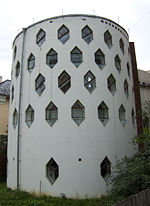
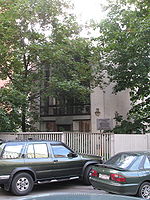 The finest existing specimen of Melnikov's work is his own Krivoarbatsky Lane residence in Moscow, completed in 1927-1929, which consists of two intersecting cylindrical towers decorated with a pattern of hexagonal windows. His flow of commissions in 1926-1927 provided enough money to finance a three-story house of his dreams. At this time, many well-to-do Russians were into building their own city houses; Melnikov was one of the few who managed to retain his property after the fall of New Economic Policy
The finest existing specimen of Melnikov's work is his own Krivoarbatsky Lane residence in Moscow, completed in 1927-1929, which consists of two intersecting cylindrical towers decorated with a pattern of hexagonal windows. His flow of commissions in 1926-1927 provided enough money to finance a three-story house of his dreams. At this time, many well-to-do Russians were into building their own city houses; Melnikov was one of the few who managed to retain his property after the fall of New Economic Policy
. His request for land (790 square meters) had few chances to pass the district commission; to his surprise, a working class commissioner supported him, saying that "we can build public buildings anytime and anywhere, but we may never see this unusual house completed if we reject Melnikov". The city endorsed Melnikov's draft as an experimental, one-of-a-kind project.
Melnikov preferred to work at home, and always wanted a spacious residence that could house his family, architectural and painting workshops. As the Russian idiom says, he designed the house starting "from the oven"; existing white oven in his living room dates back to his 1920 drawings. Floorplan evolved from a plain square to a circle and an egg shape, without much attention to exterior finishes. Melnikov developed the concept of intersecting cylinders in 1925-1926 for his Zuev Workers' Club
draft (he lost the contest to Ilya Golosov
). Twin cylinder floorplan was approved by the city in June, 1927 and was revised during construction.
The towers, top to bottom, are a honeycomb
lattice made of brickwork. 60 of more than 200 cells were glazed with windows (of three different frame designs), the rest filled with clay and scrap. This unorthodox design was a direct consequence of material rationing
by the state - Melnikov was limited to brick and wood, and even these were in short supply. The wooden ceilings have no supporting columns, nor horizontal girder
s. They were formed by a rectangular grid of flat planks, in a sort of orthotropic deck
. The largest room, a 50 square meter workshop on the third floor, is lit with 38 hexagonal windows; equally large living room has a single wide window above the main entrance.
In 1929, Melnikov proposed the same system of intersecting cylinders and cheap honeycomb structure for apartment blocks, which did not materialize.
The own house built by Konstantin Melnikov - the recognized masterpiece of architecture – is a honeycomb
lattice shell made of bricks with hexahedral cells.
The similar lattice shells out of metal were patented and
built by Vladimir Shukhov
in 1896. Melnikov built his house in 1927-1929, and by that time in Russia there had been already built about 200 Shukhov’s steel lattice shells as the overhead covers of buildings, hyperboloid water and other towers,
including the famous 160 meter radio tower
in Moscow (1922). Since Melnikov and Shukhov were well acquainted with each other and made joint projects (Bakhmetevsky Bus Garage
, Novo-Ryazanskaya Street Garage
), it is not surprising that the Melnikov’s house in Krivoarbatsky pereulok was built in the form of an original lattice shell. The overhead covers of the own Мelnikov’s house are the honeycomb
lattice shells made of wooden boards placed edgewise.
Seventh Planning Workshop, was involved in city planning projects for the south-western sector of Moscow (Arbat Square
and Khamovniki District); none of them materialized. The assignment looked like an appreciation of his talent, but in fact separated Melnikov from actual construction projects.
His final public statement was a 1936 contest entry for the Soviet pavilion at 1937 World Expo in Paris
; he lost the contest to Boris Iofan
. By 1937, mounting criticism against formalism
led to virtual excommunication of Melnikov from practice. He was not exactly forgotten; on the contrary, his Rusakov Club and Arbat house were present in many Soviet textbooks as examples of formalism.
Despite the damning status of alien artist, Melnikov retained his Arbat house and lived there with his family, safely, until his death. He returned to portrait painting and lectured at engineering colleges. Melnikov also designed privately commissioned, unimportant architectural jobs - summer houses, shop interiors, some of which materialized.
Melnikov returned to the public contest stage four times:
In 1960s, Melnikov enjoyed a brief revival of interest in his architecture. His 75th birthday (1965) was officially celebrated by the House of Architects in Moscow; in 1967 and 1972 he was awarded honorary titles of Doctor of Architecture and Meritorious Architect
.
Melnikov died at 84 and was interred at Vvedenskoye Cemetery in Lefortovo District
of Moscow. His son, Viktor, also a painter, lived and worked at the Arbat house, and fought to have it preserved as a museum until his death in February 2006. The house contains a significant portion of Konstantin S. Melnikov's archive.
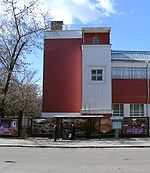
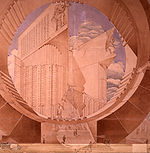
Moscow
Moscow is the capital, the most populous city, and the most populous federal subject of Russia. The city is a major political, economic, cultural, scientific, religious, financial, educational, and transportation centre of Russia and the continent...
- November 28, 1974, id.) was a Russian architect
Architect
An architect is a person trained in the planning, design and oversight of the construction of buildings. To practice architecture means to offer or render services in connection with the design and construction of a building, or group of buildings and the space within the site surrounding the...
and painter
Painting
Painting is the practice of applying paint, pigment, color or other medium to a surface . The application of the medium is commonly applied to the base with a brush but other objects can be used. In art, the term painting describes both the act and the result of the action. However, painting is...
. His architectural work, compressed into a single decade (1923–1933), placed Melnikov on the front end of 1920s avant-garde
Avant-garde
Avant-garde means "advance guard" or "vanguard". The adjective form is used in English to refer to people or works that are experimental or innovative, particularly with respect to art, culture, and politics....
architecture. Although associated with the Constructivists
Constructivist architecture
Constructivist architecture was a form of modern architecture that flourished in the Soviet Union in the 1920s and early 1930s. It combined advanced technology and engineering with an avowedly Communist social purpose. Although it was divided into several competing factions, the movement produced...
, Melnikov was an independent artist, not bound by the rules of a particular style or artistic group. In 1930s, Melnikov refused to conform with the rising stalinist architecture
Stalinist architecture
Stalinist architecture , also referred to as Stalinist Gothic, or Socialist Classicism, is a term given to architecture of the Soviet Union between 1933, when Boris Iofan's draft for Palace of the Soviets was officially approved, and 1955, when Nikita Khrushchev condemned "excesses" of the past...
, withdrew from practice and worked as a portrait painter and teacher until the end of his life.
Childhood

Nizhny Novgorod
Nizhny Novgorod , colloquially shortened to Nizhny, is, with the population of 1,250,615, the fifth largest city in Russia, ranking after Moscow, St. Petersburg, Novosibirsk, and Yekaterinburg...
region, was a road maintenance foreman, employed by the Moscow Agricultural Academy. Mother, Yelena Grigorievna (née Repkina), came from the peasants of Zvenigorod
Zvenigorod
Zvenigorod is an old town in Moscow Oblast, Russia. Population: -History:The community has existed since the 12th century, although its first written mention is dated 1338. The town's name is based either on a personal name or on a hydronym Zvenigorod is an old town in Moscow Oblast, Russia....
district. The whole family occupied a single room of a state-managed working class barrack in Hay Lodge (Соломенная Сторожка), then a quiet northern suburb of Moscow. Melnikovs tried hard to rise above bitter poverty, to return to farming and eventually relocated to their own small house and set their own dairy farm. Konstantin Melnikov later praised his father, who noticed little boy's addiction to drawing and regularly brought him scrap paper for drawing from the Academy. However, all the education they could afford was a two-year parish school (completed in 1903).
Education
Konstantin met his "golden day in life" ("это был золотой день в моей жизни") through a milk delivery woman, who happened to serve the family of Vladimir Chaplin, a wealthy engineer. She recommended Konstantin's drawings to Chaplin, who was so impressed that he hired the teenager to his firm and paid for his art studies. Chaplin overestimated Melnikov's basic education, and Konstantin failed his grammar test at the Moscow School of Painting, Sculpture and ArchitectureMoscow School of Painting, Sculpture and Architecture
The Moscow School of Painting, Sculpture and Architecture was one of the largest educational institutions in Russia. The school was formed by the 1865 merger of a private art college, established in Moscow in 1832, and the Palace School of Architecture, established in 1749 by Dmitry Ukhtomsky. By...
in 1904. One year later, he passed the admissions that selected a class of 11 out of 270 applicants. Melnikov studied at the School for 12 years, first completing General Education (1910), then graduating in Arts (1914) and Architecture (1917). Despite Chaplin's calls to concentrate on architecture, Melnikov leaned to painting; by the time he joined the Architecture classes, he already was a well-recognized portrait painter. Later, he recalled Konstantin Korovin
Konstantin Korovin
Konstantin Alekseyevich Korovin was a leading Russian Impressionist painter.-Biography:Konstantin was born in Moscow to a merchant family officially registered as "peasants of Vladimir Gubernia". His father, Aleksey Mikhailovich Korovin, earned a university degree and was more interested in arts...
, Sergey Malyutin
Sergey Malyutin
Sergey Vasilyevich Malyutin was Russian painter, architect and stage designer. He is credited with designing and painting the first Russian matryoshka doll in 1890.- References :*...
and Abram Arkhipov
Abram Arkhipov
Abram Efimovich Arkhipov was a Russian realist artist, who was a member of the art collective The Wanderers as well as the Union of Russian Artists....
as his mentors in art; as for architecture, he gave his regards only to Ivan Zholtovsky, his professor in 1917-1918.
Melnikov married Anna Yablokova in 1912; they had two children, born in 1913 and 1915.
Early career
During World War IWorld War I
World War I , which was predominantly called the World War or the Great War from its occurrence until 1939, and the First World War or World War I thereafter, was a major war centred in Europe that began on 28 July 1914 and lasted until 11 November 1918...
and the first years after Russian Revolution of 1917
Russian Revolution of 1917
The Russian Revolution is the collective term for a series of revolutions in Russia in 1917, which destroyed the Tsarist autocracy and led to the creation of the Soviet Union. The Tsar was deposed and replaced by a provisional government in the first revolution of February 1917...
, Melnikov worked within the Neoclassical tradition. Before the Revolution, he was involved in AMO Truck Plant
Zavod Imeni Likhacheva
Zavod imeni Likhachova, more commonly called ZIL is a major Russian truck and heavy equipment manufacturer, which also produced armored cars for most Soviet leaders, as well as buses, armored fighting vehicles, and aerosani...
project. In 1918-1920, he was employed by the New Moscow planning workshop headed by Zholtovsky and Alexey Shchusev
Alexey Shchusev
Alexey Viktorovich Shchusev ), 1873, Chişinău—24 May 1949, Moscow) was an acclaimed Russian and Soviet architect whose works may be regarded as a bridge connecting Revivalist architecture of Imperial Russia with Stalin's Empire Style....
, designing Khodynka
Khodynka
Khodynka Field is a large open space in the north-west of Moscow, at the beginning of the present day Leningradsky Prospect. It takes its name from the small Khodynka River which used to cross the neighbourhood...
and Butyrsky District
Butyrsky District
Butyrsky District is an administrative district of North-Eastern Administrative Okrug, and one of the 125 raions of Moscow, Russia....
sectors of the city.
Meanwhile, the Russian educational system collapsed; the new art college, VKhUTEMAS
VKhUTEMAS
Vkhutemas ) was the Russian state art and technical school founded in 1920 in Moscow, replacing the Moscow Svomas. The workshops were established by a decree from Vladimir Lenin with the intentions, in the words of the Soviet government, "to prepare master artists of the highest qualifications for...
, was formed in 1920. Its architectural faculty was split between three factions: An Academic Workshop (Ivan Zholtovsky), left-wing United Workshops (Nikolai Ladovsky
Nikolai Ladovsky
Nikolai Alexandrovich Ladovsky was a Russian avant-garde architect and educator, leader of the rationalist movement in 1920s architecture, an approach emphasizing human perception of space and shape...
), and a joint workshop of Melnikov and Ilya Golosov, known as New Academy and Workshop No.2. Melnikov and Golosov resisted both the academic and left-wing camps; in 1924, when the management merged New Academy with Academic Workshop, Melnikov quit VKhUTEMAS. In 1923-1924, Melnikov temporarily associated himself with the ASNOVA
ASNOVA
ASNOVA was an Avant-Garde architectural association in the Soviet Union, which was active in the 1920s and early 1930s, commonly called 'the Rationalists'....
and LEF
LEF (journal)
LEF was the journal of the Left Front of the Arts , a widely ranging association of avant-garde writers, photographers, critics and designers in the Soviet Union. It had two runs, one from 1923 to 1925 as LEF, and later from 1927 to 1929 as Novy LEF...
artistic groups, however, he was not involved in public disputes and made no public statements. In particular, he clearly distanced himself from the Constructivist
Constructivist architecture
Constructivist architecture was a form of modern architecture that flourished in the Soviet Union in the 1920s and early 1930s. It combined advanced technology and engineering with an avowedly Communist social purpose. Although it was divided into several competing factions, the movement produced...
group, led by Moisei Ginzburg
Moisei Ginzburg
Moisei Yakovlevich Ginzburg was a Soviet constructivist architect, best known for his 1929 Narkomfin Building in Moscow.-Education:Ginzburg was born in Minsk in a Jewish real estate developer's family. He graduated from Milano Academy and Riga polytechnic institute . During Russian Civil War he...
and Alexander Vesnin
Alexander Vesnin
Alexander Aleksandrovic Vesnin , together with his brothers Leonid Aleksandrovic Vesnin and Viktor Aleksandrovic Vesnin he was a leading light of Constructivist architecture...
.
His first success in architecture was a 1922 entry to a workers' housing contest. Codenamed Atom, Melnikov's design employed the sawtooth arrangement of units that became his trademark in later works. Unlike other, "revolutionary" projects, Atom was based on traditional single-family townhouse
Terraced house
In architecture and city planning, a terrace house, terrace, row house, linked house or townhouse is a style of medium-density housing that originated in Great Britain in the late 17th century, where a row of identical or mirror-image houses share side walls...
and apartment units.
Melnikov's first materialized works were short-lived, temporary buildings. The first, a 1923 pavilion for the All-Russian Agriculture and Handicraft Exhibition, featured more Melnikov trademarks:
- Raised cubical shapes are offset from supporting columns
- Combination of single-sloped roofRoofA roof is the covering on the uppermost part of a building. A roof protects the building and its contents from the effects of weather. Structures that require roofs range from a letter box to a cathedral or stadium, dwellings being the most numerous....
s - Glazed corners
The latter feature is shared with the Constructivists; single-sloped, angled roof was against the constructivist canon but a good match to existing technologies: Soviet industry of 1920s did not have the technology for reliable flat roofing.
Melnikov Garage

Exposition Internationale des Arts Décoratifs et Industriels Modernes
The International Exposition of Modern Industrial and Decorative Arts was a World's fair held in Paris, France, from April to October 1925. The term "Art Deco" was derived by shortening the words Arts Décoratifs, in the title of this exposition, but not until the late 1960s by British art critic...
. The wooden pavilion, employing a combination of single-sloped roofs of different sizes, was regarded as being one of the most progressive buildings at the fair. Unlike other Paris pavilions, it was completed in less than a month, employing not more than 10 workers.
Still in Paris, Melnikov designed two privately-commissioned version of a ramped garage that never got past the conceptual drawing stage. The second version of this project, according to Andrés Jaque
Andrés Jaque
Andrés Jaque is an architect. His work explores the role architecture plays in the making of societies. He has been considered one of the most challenging contemporary European architects.-Life and career:...
's studies, has been strongly influential in contemporary architectects like Rem Koolhaas
Rem Koolhaas
Remment Lucas Koolhaas is a Dutch architect, architectural theorist, urbanist and "Professor in Practice of Architecture and Urban Design" at the Graduate School of Design at Harvard University, USA. Koolhaas studied at the Netherlands Film and Television Academy in Amsterdam, at the Architectural...
, especially in his proposal for the National Library of France or Foreign Office's Yokohama Terminal. However, Melnikov found a useful pattern of placing cars in a garage (again, a sawtooth pattern) where cars could park and leave without using reverse gear. The second In Moscow, Melnikov saw a new fleet of Leyland buses hoarded in a yard in Zamoskvorechye
Zamoskvorechye
Zamoskvorechye District is a district of Central Administrative Okrug in Moscow, Russia. Population: The district contains the eastern half of historical Zamoskvorechye area , and the territories of Zatsepa Street and Paveletsky Rail Terminal south of the Garden Ring...
, and immediately proposed his concept to the city. The result, Bakhmetevsky Bus Garage
Bakhmetevsky Bus Garage
Bakhmetevsky Bus Garage was a public bus garage in Moscow, designed in 1926 by Konstantin Melnikov and Vladimir Shukhov . The building, completed in 1927, was an example of applying avant-garde architectural methods to an industrial facility...
, housed 104 buses on 8500 square meters of an unconventional, parallelogram
Parallelogram
In Euclidean geometry, a parallelogram is a convex quadrilateral with two pairs of parallel sides. The opposite or facing sides of a parallelogram are of equal length and the opposite angles of a parallelogram are of equal measure...
-shaped floorplan with Vladimir Shukhov
Vladimir Shukhov
Vladimir Grigoryevich Shukhov , was a Russian engineer-polymath, scientist and architect renowned for his pioneering works on new methods of analysis for structural engineering that led to breakthroughs in industrial design of world's first hyperboloid structures, lattice shell structures, tensile...
's roof system.

- 1926-1929: Horseshoe-shaped truck garageNovo-Ryazanskaya Street GarageNovoryazanskaya Street Garage, also spelled Novo-Ryazanskaya Street Garage, and known as "Horseshoe garage", was designed by Konstantin Melnikov and Vladimir Shukhov in 1926 and completed in 1929 at 27, Novoryazanskaya Street in Krasnoselsky District, Moscow, Russia, near Kazansky Rail...
, Novo-Ryazanskaya Street (with Vladimir ShukhovVladimir ShukhovVladimir Grigoryevich Shukhov , was a Russian engineer-polymath, scientist and architect renowned for his pioneering works on new methods of analysis for structural engineering that led to breakthroughs in industrial design of world's first hyperboloid structures, lattice shell structures, tensile...
) - 1933-1936: IntouristIntouristIntourist is a Russian travel agency, 66%-owned by Moscow-based holding company Sistema.Before privatisation in 1992, Intourist was renowned as the official state travel agency of the Soviet Union. It was founded in 1929 by Joseph Stalin and was staffed by NKVD and later KGB officials...
car garage, Suschevsky Val Street (with Andrey Kurochkin) - 1934-1936: GosplanGosplanGosplan or State Planning Committee was the committee responsible for economic planning in the Soviet Union. The word "Gosplan" is an abbreviation for Gosudarstvenniy Komitet po Planirovaniyu...
car garage, Aviamotornaya Street
Melnikov Clubs

Monopoly
A monopoly exists when a specific person or enterprise is the only supplier of a particular commodity...
takeover... that's how love will treat you if she really loves you" ("Начиная с 1927, мой авторитет вырос в монопольный захват... вот так поступит любовь и с Вами, если она Вас полюбит").
Nation-wide construction of new, dedicated buildings for workers' clubs (combining propaganda, educational and community center functions) was launched in 1926 and peaked in 1927, when trade unions commissioned 30 clubs in Moscow region (10 in the city of Moscow). Melnikov won five of these ten projects (his sixth club is located in Likino-Dulyovo
Likino-Dulyovo
Likino-Dulyovo is a town in Orekhovo-Zuyevsky District of Moscow Oblast, Russia, located northeast of Moscow. Population: The urban-type settlement of Likino-Dulyovo was formed in 1930 by merging the settlements of Likino and Dulyovo...
). Absence of public contests for these buildings was favorable to Melnikov, who was promoted by enthusiastic trade union commissioners, regardless of design compexity or political and artistic affiliations. He had a chance to build practically exactly as planned, with very little changes by the client (notably, omission of swimming pools).
All six workers' clubs of this period differ in shape, size, and functional set. Melnikov's clients (the unions) were not competent in exact functions of these buildings, thus each Melnikov draft is also a functional program with different balance between main hall and other space. The club, according to Melnikov, is not a single fixed theater hall, but a flexible system of different halls that may be united into a single, large volume when necessary. His larger main halls can be divided into three (Rusakov Club) or two (Svoboda Club) independent halls.
One common feature of his clubs - bold use of exterior stairs - is actually a consequence of 1920s building codes that required wide internal staircase for fire evacuation. Melnikov, in an attempt to save interior space, connected the main halls to exterior galleries, which was not regulated by the code.
Melnikov House


New Economic Policy
The New Economic Policy was an economic policy proposed by Vladimir Lenin, who called it state capitalism. Allowing some private ventures, the NEP allowed small animal businesses or smoke shops, for instance, to reopen for private profit while the state continued to control banks, foreign trade,...
. His request for land (790 square meters) had few chances to pass the district commission; to his surprise, a working class commissioner supported him, saying that "we can build public buildings anytime and anywhere, but we may never see this unusual house completed if we reject Melnikov". The city endorsed Melnikov's draft as an experimental, one-of-a-kind project.
Melnikov preferred to work at home, and always wanted a spacious residence that could house his family, architectural and painting workshops. As the Russian idiom says, he designed the house starting "from the oven"; existing white oven in his living room dates back to his 1920 drawings. Floorplan evolved from a plain square to a circle and an egg shape, without much attention to exterior finishes. Melnikov developed the concept of intersecting cylinders in 1925-1926 for his Zuev Workers' Club
Zuev Workers' Club
The Zuyev Workers' Club in Moscow is a prominent work of constructivist architecture. It was designed by Ilya Golosov during 1926 and finished during 1928...
draft (he lost the contest to Ilya Golosov
Ilya Golosov
Ilya Alexandrovich Golosov was a Russian Soviet architect. A leader of Constructivism in 1925-1931, Ilya Golosov later developed his own style of early stalinist architecture known as postconstructivism...
). Twin cylinder floorplan was approved by the city in June, 1927 and was revised during construction.
The towers, top to bottom, are a honeycomb
Honeycomb
A honeycomb is a mass of hexagonal waxcells built by honey bees in their nests to contain their larvae and stores of honey and pollen.Beekeepers may remove the entire honeycomb to harvest honey...
lattice made of brickwork. 60 of more than 200 cells were glazed with windows (of three different frame designs), the rest filled with clay and scrap. This unorthodox design was a direct consequence of material rationing
Rationing
Rationing is the controlled distribution of scarce resources, goods, or services. Rationing controls the size of the ration, one's allotted portion of the resources being distributed on a particular day or at a particular time.- In economics :...
by the state - Melnikov was limited to brick and wood, and even these were in short supply. The wooden ceilings have no supporting columns, nor horizontal girder
Girder
A girder is a support beam used in construction. Girders often have an I-beam cross section for strength, but may also have a box shape, Z shape or other forms. Girder is the term used to denote the main horizontal support of a structure which supports smaller beams...
s. They were formed by a rectangular grid of flat planks, in a sort of orthotropic deck
Orthotropic deck
An orthotropic bridge or orthotropic deck is one whose deck typically comprises a structural steel deck plate stiffened either longitudinally or transversely, or in both directions. This allows the deck both to directly bear vehicular loads and to contribute to the bridge structure's overall...
. The largest room, a 50 square meter workshop on the third floor, is lit with 38 hexagonal windows; equally large living room has a single wide window above the main entrance.
In 1929, Melnikov proposed the same system of intersecting cylinders and cheap honeycomb structure for apartment blocks, which did not materialize.
The own house built by Konstantin Melnikov - the recognized masterpiece of architecture – is a honeycomb
Honeycomb
A honeycomb is a mass of hexagonal waxcells built by honey bees in their nests to contain their larvae and stores of honey and pollen.Beekeepers may remove the entire honeycomb to harvest honey...
lattice shell made of bricks with hexahedral cells.
The similar lattice shells out of metal were patented and
built by Vladimir Shukhov
Vladimir Shukhov
Vladimir Grigoryevich Shukhov , was a Russian engineer-polymath, scientist and architect renowned for his pioneering works on new methods of analysis for structural engineering that led to breakthroughs in industrial design of world's first hyperboloid structures, lattice shell structures, tensile...
in 1896. Melnikov built his house in 1927-1929, and by that time in Russia there had been already built about 200 Shukhov’s steel lattice shells as the overhead covers of buildings, hyperboloid water and other towers,
including the famous 160 meter radio tower
Shukhov Tower
The Shukhov radio tower , also known as the Shabolovka tower, is a broadcasting tower in Moscow designed by Vladimir Shukhov. The 160-metre-high free-standing steel structure was built in the period 1920–1922, during the Russian Civil War...
in Moscow (1922). Since Melnikov and Shukhov were well acquainted with each other and made joint projects (Bakhmetevsky Bus Garage
Bakhmetevsky Bus Garage
Bakhmetevsky Bus Garage was a public bus garage in Moscow, designed in 1926 by Konstantin Melnikov and Vladimir Shukhov . The building, completed in 1927, was an example of applying avant-garde architectural methods to an industrial facility...
, Novo-Ryazanskaya Street Garage
Novo-Ryazanskaya Street Garage
Novoryazanskaya Street Garage, also spelled Novo-Ryazanskaya Street Garage, and known as "Horseshoe garage", was designed by Konstantin Melnikov and Vladimir Shukhov in 1926 and completed in 1929 at 27, Novoryazanskaya Street in Krasnoselsky District, Moscow, Russia, near Kazansky Rail...
), it is not surprising that the Melnikov’s house in Krivoarbatsky pereulok was built in the form of an original lattice shell. The overhead covers of the own Мelnikov’s house are the honeycomb
Honeycomb
A honeycomb is a mass of hexagonal waxcells built by honey bees in their nests to contain their larvae and stores of honey and pollen.Beekeepers may remove the entire honeycomb to harvest honey...
lattice shells made of wooden boards placed edgewise.
End of career
Throughout 1933-1937, Melnikov, as a leader of MossovetMossovet
Mossovet , an abbreviation of Moscow Soviet of People's Deputies, was the informal name of *parallel, shadow city administration of Moscow, Russia run by left-wing parties in 1917*city administration of Moscow in Soviet period...
Seventh Planning Workshop, was involved in city planning projects for the south-western sector of Moscow (Arbat Square
Arbat Square
Arbatskaya Square of Arbat Square is one of the oldest squares of Moscow, located on the junction of Gogolevsky Boulevard, Znamenka Street and Arbat Gates Square ....
and Khamovniki District); none of them materialized. The assignment looked like an appreciation of his talent, but in fact separated Melnikov from actual construction projects.
His final public statement was a 1936 contest entry for the Soviet pavilion at 1937 World Expo in Paris
Exposition Internationale des Arts et Techniques dans la Vie Moderne (1937)
The Exposition Internationale des Arts et Techniques dans la Vie Moderne was held from May 25 to November 25, 1937 in Paris, France...
; he lost the contest to Boris Iofan
Boris Iofan
Boris Mihailovich Iofan was a Russian Soviet architect, known for his Stalinist architecture buildings like 1931 House on Embankment and the 1931-1933 winning draft of the Palace of Soviets.- Background :...
. By 1937, mounting criticism against formalism
Formalism (art)
In art theory, formalism is the concept that a work's artistic value is entirely determined by its form--the way it is made, its purely visual aspects, and its medium. Formalism emphasizes compositional elements such as color, line, shape and texture rather than realism, context, and content...
led to virtual excommunication of Melnikov from practice. He was not exactly forgotten; on the contrary, his Rusakov Club and Arbat house were present in many Soviet textbooks as examples of formalism.
Despite the damning status of alien artist, Melnikov retained his Arbat house and lived there with his family, safely, until his death. He returned to portrait painting and lectured at engineering colleges. Melnikov also designed privately commissioned, unimportant architectural jobs - summer houses, shop interiors, some of which materialized.
Melnikov returned to the public contest stage four times:
- 1954 - for the PantheonPantheon, MoscowThe Pantheon , officially also called the Monument to the Eternal Glory of the Great People of the Soviet Land , was a project to construct a monumental memorial tomb in Moscow, Soviet Union...
and 300 years of Russian-Ukrainian Unity monument - 1958 - Palace of SovietsPalace of SovietsThe Palace of the Soviets was a project to construct an administrative center and a congress hall in Moscow, Russia, near the Kremlin, on the site of the demolished Cathedral of Christ the Saviour...
(post-WWIIWorld War IIWorld War II, or the Second World War , was a global conflict lasting from 1939 to 1945, involving most of the world's nations—including all of the great powers—eventually forming two opposing military alliances: the Allies and the Axis...
contest) - 1962 - Soviet Pavilion at the 1964 New York World's Fair1964 New York World's FairThe 1964/1965 New York World's Fair was the third major world's fair to be held in New York City. Hailing itself as a "universal and international" exposition, the fair's theme was "Peace Through Understanding," dedicated to "Man's Achievement on a Shrinking Globe in an Expanding Universe";...
- 1967 - Cinema on Arbat Street (next to his own house)
In 1960s, Melnikov enjoyed a brief revival of interest in his architecture. His 75th birthday (1965) was officially celebrated by the House of Architects in Moscow; in 1967 and 1972 he was awarded honorary titles of Doctor of Architecture and Meritorious Architect
Meritorious Artist
Meritorious Artist , also translated as Merited Artist, Deserved Artist or Distinguished Artist or Honorary Artist or Honorable Actor) is an honorary title in the Soviet Union, Russian Federation, Union republics, and Autonomous republics, also in some other Eastern bloc states, as well as in a...
.
Melnikov died at 84 and was interred at Vvedenskoye Cemetery in Lefortovo District
Lefortovo District
Lefortovo District is a district of South-Eastern Administrative Okrug of Moscow, Russia. Population: It is named after a close associate of Tsar Peter the Great Franz Lefort, whose troops were stationed nearby at the German Quarter. The district is considered to be founded in 1699. In the 18th...
of Moscow. His son, Viktor, also a painter, lived and worked at the Arbat house, and fought to have it preserved as a museum until his death in February 2006. The house contains a significant portion of Konstantin S. Melnikov's archive.
Completed buildings

- 1915–1917 - Junior architect for the AMO Truck Plant housing and offices, Moscow (destroyed)
- 1923 - Makhorka Pavilion for the All Russian Agricultural and Handicraft Industries Exhibition, Moscow (destroyed)
- 1924–1925 - New Sukharev Market in Moscow (destroyed)
- 1925 - Competition entry for the USSR Pavilion of the Exposition Internationale des Arts Décoratifs et Industriels ModernesExposition Internationale des Arts Décoratifs et Industriels ModernesThe International Exposition of Modern Industrial and Decorative Arts was a World's fair held in Paris, France, from April to October 1925. The term "Art Deco" was derived by shortening the words Arts Décoratifs, in the title of this exposition, but not until the late 1960s by British art critic...
, Paris (destroyed) - 1926–1927 - Bakhmetevsky Bus GarageBakhmetevsky Bus GarageBakhmetevsky Bus Garage was a public bus garage in Moscow, designed in 1926 by Konstantin Melnikov and Vladimir Shukhov . The building, completed in 1927, was an example of applying avant-garde architectural methods to an industrial facility...
, 11 Obraztsova Street, Moscow - 1927–1929: The "Golden Season" of Melnikov
- Kauchuk Factory ClubKauchuk Factory ClubKauchuk Factory Club is a 1927-1929 constructivist public building designed by Konstantin Melnikov, located in Khamovniki District of Moscow, Russia on the edge of Devichye Pole park and medical campus at 64, Plyshikha Street.-History and architecture:...
, 64 Plyuschikha Street, Moscow - Burevestnik Factory Club, Moscow
- Svoboda Factory ClubSvoboda Factory ClubSvoboda Factory Club , conceived as Chemists Trade Union Club , also known as Maxim Gorky Palace of Culture , is a listed memorial avant-garde building in Moscow, Russia, designed by Konstantin Melnikov in 1927 and completed in 1929...
, 41 Vyatskaya Street, Moscow (also known as Gorky Palace of Culture) - Rusakov Workers' Club, 6 Stromynka Street, Moscow
- Frunze Workers' Club, 28, Berezhkovskaya Embankment, Moscow (endangered)
- Porcelain Factory Club, Likino-DulyovoLikino-DulyovoLikino-Dulyovo is a town in Orekhovo-Zuyevsky District of Moscow Oblast, Russia, located northeast of Moscow. Population: The urban-type settlement of Likino-Dulyovo was formed in 1930 by merging the settlements of Likino and Dulyovo...
(also referred to simply as Dulyovo) - Melnikov's own residence, Krivoarbatsky Lane, Moscow
- Novo-Ryazanskaya Street GarageNovo-Ryazanskaya Street GarageNovoryazanskaya Street Garage, also spelled Novo-Ryazanskaya Street Garage, and known as "Horseshoe garage", was designed by Konstantin Melnikov and Vladimir Shukhov in 1926 and completed in 1929 at 27, Novoryazanskaya Street in Krasnoselsky District, Moscow, Russia, near Kazansky Rail...
(Horseshoe Garage), 27 Novoryazanskaya Street, Moscow
- Kauchuk Factory Club
- 1930–1931 - Reconstruction of Kamerny Theater in Moscow
- 1934–1936 - Intourist Garage, Aviamotornaya Street, Moscow
- 1934–1936 - Gosplan Garage, 33 Suschevsky Val Street, Moscow
- 1937–1938 - Novinsky Boulevard planning, Moscow
- 1945–1947 - Exterior paint scheme design for Mikoyan Slaughterhouses, Moscow (destroyed)
Selected competition entries and concepts

- 1918–1920 - Drafts of workers' housing, Alexeyevskaya Hospital housing and the People's House in Moscow (not related to his 1922 drafts)
- 1921–1923 - Competition entry for workers' housing and for the Palace of Labour, Moscow (never built)
- 1921–1923 - Butyrsky District and KhodynkaKhodynkaKhodynka Field is a large open space in the north-west of Moscow, at the beginning of the present day Leningradsky Prospect. It takes its name from the small Khodynka River which used to cross the neighbourhood...
planning for the New Moscow master plan (never completed) - 1924 - Design of Lenin's sarcophagusLenin's MausoleumLenin's Mausoleum also known as Lenin's Tomb, situated in Red Square in the center of Moscow, is the mausoleum that serves as the current resting place of Vladimir Lenin. His embalmed body has been on public display there since shortly after his death in 1924...
(awarded to Alexey ShchusevAlexey ShchusevAlexey Viktorovich Shchusev ), 1873, Chişinău—24 May 1949, Moscow) was an acclaimed Russian and Soviet architect whose works may be regarded as a bridge connecting Revivalist architecture of Imperial Russia with Stalin's Empire Style....
, author of first, temporary Mausoleum) - 1924–1925 - Competition entry for the Moscow bureau of the newspaper Leningrad Pravda http://www.utopia.ru/english/item.phtml?id=166&type=graphics&sortby=view&start=0 (won by Vesnin brothersVesnin brothersThe Vesnin brothers: Leonid Vesnin , Victor Vesnin and Alexander Vesnin were the leaders of Constructivist architecture, the dominant architectural school of the Soviet Union in the 1920s and early 1930s...
, never built) - 1925 - Garage concepts for the new SeineSeineThe Seine is a -long river and an important commercial waterway within the Paris Basin in the north of France. It rises at Saint-Seine near Dijon in northeastern France in the Langres plateau, flowing through Paris and into the English Channel at Le Havre . It is navigable by ocean-going vessels...
bridges in ParisParisParis is the capital and largest city in France, situated on the river Seine, in northern France, at the heart of the Île-de-France region... - 1927 - Zuev Workers' Club, Moscow (awarded to Ilya GolosovIlya GolosovIlya Alexandrovich Golosov was a Russian Soviet architect. A leader of Constructivism in 1925-1931, Ilya Golosov later developed his own style of early stalinist architecture known as postconstructivism...
, see executed buildingZuev Workers' ClubThe Zuyev Workers' Club in Moscow is a prominent work of constructivist architecture. It was designed by Ilya Golosov during 1926 and finished during 1928...
) - 1928 - Gorky Park (Moscow)Gorky Park (Moscow)Gorky Central Park of Culture and Leisure is an amusement park in Moscow, named after Maxim Gorky.-History:...
, landscape project - 1929 - Competition entry for the Monument of Christopher Columbus, Santo DomingoSanto DomingoSanto Domingo, known officially as Santo Domingo de Guzmán, is the capital and largest city in the Dominican Republic. Its metropolitan population was 2,084,852 in 2003, and estimated at 3,294,385 in 2010. The city is located on the Caribbean Sea, at the mouth of the Ozama River...
.http://www.utopia.ru/english/item.phtml?id=97&type=graphics&sortby=view&start=0 (never built) - 1932–1933 - Competition entry for the Palace of the Soviets (project awarded to Boris IofanBoris IofanBoris Mihailovich Iofan was a Russian Soviet architect, known for his Stalinist architecture buildings like 1931 House on Embankment and the 1931-1933 winning draft of the Palace of Soviets.- Background :...
and Vladimir Shchuko, never built) - 1934 - Competition entry for the NarkomtiazhpromNarkomtiazhpromThe Narkomtiazhprom was a 1934 architectural contest for the People's Commissariat of Construction of Heavy Industry, to be constructed in Red Square, Moscow...
building, Red Square, Moscow (never built) - 1934–1936 - Planning drafts for LuzhnikiLuzhnikiLuzhniki may refer to:*Luzhniki , a village in Moscow Oblast, Russia*Luzhniki Olympic Complex, sport complex in Moscow, Russia.**Luzhniki Palace of Sports, an arena in Luzhniki Olympic Complex...
, Kotelnicheskaya EmbankmentKotelnicheskaya EmbankmentKotelnicheskaya Embankment is a street on the northern bank of Moskva River in central Tagansky District of Moscow, Russia. It spans from the mouth of Yauza River to the point one block west from Bolshoy Krashokholmsky Bridge , where it changes name to Goncharnaya Embankment.-Kotelnicheskaya...
and other city planning proposals - 1936 - Competition entry for the Soviet Pavilion at the Exposition Internationale des Arts et Techniques dans la Vie Moderne (1937)Exposition Internationale des Arts et Techniques dans la Vie Moderne (1937)The Exposition Internationale des Arts et Techniques dans la Vie Moderne was held from May 25 to November 25, 1937 in Paris, France...
(awarded to Boris IofanBoris IofanBoris Mihailovich Iofan was a Russian Soviet architect, known for his Stalinist architecture buildings like 1931 House on Embankment and the 1931-1933 winning draft of the Palace of Soviets.- Background :...
, completed and destroyed in 1936) - 1954–1955 - Competition entries for the Pantheon and the monument to 300 years of Russian-Ukrainian Unity (never built)
- 1958–1959 - Competition entry for the Palace of the Soviets (post-war round, never built)
- 1962 - USSR Pavilion for the World Expo in New York City
- 1967 - Competition entry for the cinema in Arbat Street (never built)
External links
- Housing.com video and profile of Melnikov House
- Melnikov House Museum
- Melnikov House, Additional Info
- Photo of Melnikov House
- On preserving Moscow's heritage of revolutionary architecture
- Agram Saariste archive
- Russian Avant-garde Heritage Preservation Foundation
- Video of Gosplan Garage
- Contemporary video and profile of Rusakov Workers Club

